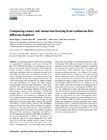Comparing contact and immersion freezing from continuous flow diffusion chambers

Open access
Date
2016Type
- Journal Article
Abstract
Ice nucleating particles (INPs) in the atmosphere are responsible for glaciating cloud droplets between 237 and 273K. Different mechanisms of heterogeneous ice nucleation can compete under mixed-phase cloud conditions. Contact freezing is considered relevant because higher ice nucleation temperatures than for immersion freezing for the same INPs were observed. It has limitations because its efficiency depends on the number of collisions between cloud droplets and INPs. To date, direct comparisons of contact and immersion freezing with the same INP, for similar residence times and concentrations, are lacking. This study compares immersion and contact freezing efficiencies of three different INPs. The contact freezing data were obtained with the ETH CoLlision Ice Nucleation CHamber (CLINCH) using 80µm diameter droplets, which can interact with INPs for residence times of 2 and 4s in the chamber. The contact freezing efficiency was calculated by estimating the number of collisions between droplets and particles. Theoretical formulations of collision efficiencies gave too high freezing efficiencies for all investigated INPs, namely AgI particles with 200nm electrical mobility diameter, 400 and 800nm diameter Arizona Test Dust (ATD) and kaolinite particles. Comparison of freezing efficiencies by contact and immersion freezing is therefore limited by the accuracy of collision efficiencies. The concentration of particles was 1000cm−3 for ATD and kaolinite and 500, 1000, 2000 and 5000cm−3 for AgI. For concentrations < 5000cm−3, the droplets collect only one particle on average during their time in the chamber. For ATD and kaolinite particles, contact freezing efficiencies at 2s residence time were smaller than at 4s, which is in disagreement with a collisional contact freezing process but in accordance with immersion freezing or adhesion freezing. With “adhesion freezing”, we refer to a contact nucleation process that is enhanced compared to immersion freezing due to the position of the INP on the droplet, and we discriminate it from collisional contact freezing, which assumes an enhancement due to the collision of the particle with the droplet. For best comparison with contact freezing results, immersion freezing experiments of the same INPs were performed with the continuous flow diffusion chamber Immersion Mode Cooling chAmber–Zurich Ice Nucleation Chamber (IMCA–ZINC) for a 3s residence time. In IMCA–ZINC, each INP is activated into a droplet in IMCA and provides its surface for ice nucleation in the ZINC chamber. The comparison of contact and immersion freezing results did not confirm a general enhancement of freezing efficiency for contact compared with immersion freezing experiments. For AgI particles the onset of heterogeneous freezing in CLINCH was even shifted to lower temperatures compared with IMCA–ZINC. For ATD, freezing efficiencies for contact and immersion freezing experiments were similar. For kaolinite particles, contact freezing became detectable at higher temperatures than immersion freezing. Using contact angle information between water and the INP, it is discussed how the position of the INP in or on the droplets may influence its ice nucleation activity. Show more
Permanent link
https://doi.org/10.3929/ethz-b-000118903Publication status
publishedExternal links
Journal / series
Atmospheric Chemistry and PhysicsVolume
Pages / Article No.
Publisher
CopernicusOrganisational unit
03690 - Lohmann, Ulrike / Lohmann, Ulrike
More
Show all metadata


